Preparing your Dog for Baby’s Arrival
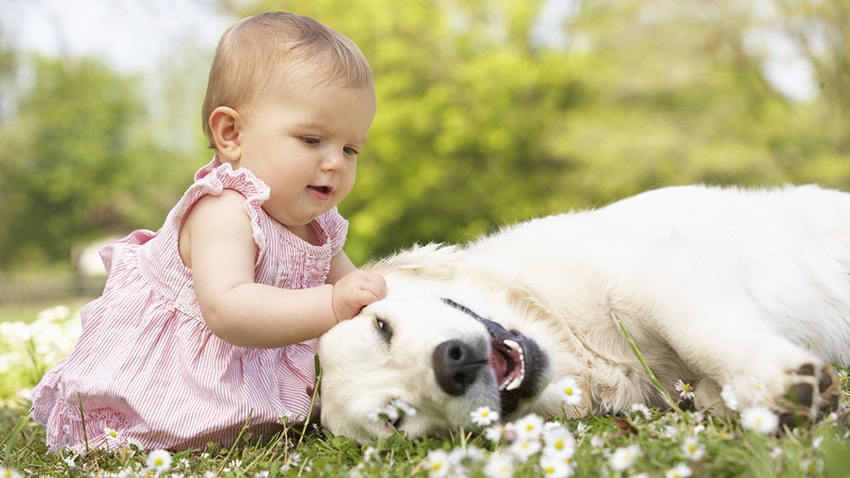
When Lucie was born, we were very nervous about introducing our dog to her. Upon bringing her home from the hospital, our loving 7-year old pit bull mix (Sugar) would pace nervously back and forth around her Pack n’ Play as our baby napped in the living room. Feeling uneasy about this, I Googled local dog trainers, which led me to dog/baby expert and author Mike Wombacher.
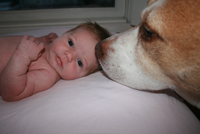
Mike successfully helped us through this situation and just recently developed an e-Course version (discussed below) of his book, Good Dog Happy Baby, to help new parents prepare their dog for a new baby.
I demo’d the course for him (loved it!) and told him I would happily bring it to our audience. The course is self-paced and especially great for people who don’t have the local resources to get this type of training in-person. Full disclosure: I get a small commission if you purchase the course, but I think you’ll like it as much as I did.
We’ve had a close (adult) family member suffer a traumatic bite to the face (from a different dog) and there is nothing that can undo that scar. My own husband was bitten as a toddler when getting into his dog’s food, so it’s an issue we (unfortunately) know well.
His article (below) is full of quick tips for dealing with the critical phases of introducing dog to baby; it will also help you assess whether or not your dog is a candidate for the full course. Enjoy!
Dogs and Babies, by Mike Wombacher
Dog ownership has skyrocketed in the past 30 years; at the same time, young couples are increasingly choosing to delay parenthood into their late 20s, 30s and even 40s.
At the intersection of these trends, dogs have found a new social role: surrogate child.
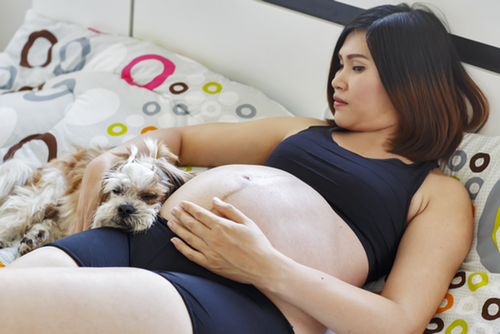
Having poured years of love and affection into their pet(s), too little thought is given to how their “fur baby” will take to the sudden arrival of a human baby.
—————-
Over the last few decades, dogs have worked their way up the hierarchy from the backyard to the bedroom. Literally. They’ve become our companions in ways and quantities never seen before.
Today, most of us don’t need dogs to hunt, guard, herd or kill vermin; we want their companionship, love and affection. And dogs, who are emotionally similar to us, are capable of providing this in spades.
Anyone who’s ever owned a dog knows they can feel much as much as we do. That means that dogs, like people, can get jealous and insecure. Like humans, they’re prone to feel unloved or neglected when they’re no longer the center of attention.
Imagine how a dog – one who’s been at the heart of an owner’s world – feels when they’re displaced from that emotional center by the arrival of a baby.
Unfortunately, too few parents-to-be consider how to prepare their beloved “first baby” for this turn of events. To the degree they consider the issue at all, they generally assume all will be well.
“My dog loves me,” they know, “and will love and protect my baby just as well.” In this presumption often lies the seeds of catastrophe. Over the years I’ve had numerous clients who dismissed my warnings about potential dog-baby problems, only to deeply regret it later.
Alarming Stats
Every year in the United States, there are roughly 4.5 million reported dog bites. About 800,000 of these require hospitalization. About 30,000 of them require reconstructive surgery.
And here comes the worst part: 80% of these bites happen to children under 5 and 80% of those occur on the face and neck. Add to that, about 90% of them come from the family dog or a dog the child knew.
The net result? By the age of 12, fully 50% of American children have been bitten by a dog and a significant number of them suffer symptoms of PTSD.
Editor’s Note: I chose not to insert a photo of a baby or child attacked by a dog because they were, in fact, too disturbing. One look at this library of photos and I assure you, you will never feel the same.
This situation has become so severe that (at time of publish) the Centers for Disease Control (CDC) has labeled dog bites on children an “epidemic”, second only to teen substance abuse, as a threat to child welfare.
If you’re thinking to yourself it’s all going to be fine, I suggest you re-read the aforementioned data and let those numbers sink in. This isn’t just an issue because people are too lazy, not educated or don’t have enough money. It’s mostly an issue because it doesn’t occur to most pet owners that it will be a problem.
This is why, for many parents, things are increasingly ending up not-so-fine. I’ve seen too many sad situations where Fido was the king/queen of the house one day, and several weeks later, on the way to a shelter. That’s what first prompted me to write Good Dog, Happy Baby almost twenty years ago. I knew that, in most cases, such scenarios were easily preventable with just a little forethought.
Here’s what a little forethought looks like…
Begin by asking yourself key questions: Does your dog like children? Is she sensitive to touch? Is she afraid of loud, sudden noises? Does she bark incessantly? Does she suffer from separation anxiety?
The answers to these questions can help you design a road map for preparing your dog for your baby’s arrival. (For a comprehensive list of questions, download a free pdf of 22 such questions from my website).
The goal is to identify problem areas and make any changes in your dog’s life to situations your dog might find unpleasant, such as reduced time together, long before your baby’s arrival. Why? So your dog won’t associate such changes with baby’s arrival – a situation that could eventually trigger an unhealthy competitive dynamic between the two of them.
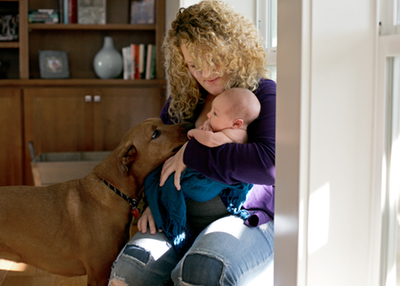
Your roadmap should include special consideration of three key thresholds in your baby’s life.
Stage 1: Preparing for Baby’s Arrival
Once you’ve identified the structural changes that need to take place, you should implement those changes to your dog’s life long before your baby arrives. This could include anything from spending less time with your dog to suddenly having a lot more people in the house to not allowing your dog on beds, furniture or special rooms like the nursery.
How long before? It depends on your dog and how deeply embedded in your routine she is. At a minimum, changes should be implemented no less than a month before your due date. At a maximum, begin the moment you find out you’re pregnant.
The goal is to prevent your dog from associating these undesirable changes before your baby’s arrival so she doesn’t begin nursing a grudge.
Stage 2: Late Infancy – Crawling and Grabbing
The second critical period begins as your baby approaches 8 months of age (give or take) and begins crawling and grabbing. By this point, you should have already worked hard to condition your dog to the awkward grabbing and pulling at sensitive body parts that a baby will inevitably go for (i.e. rough handling), especially for those dogs who already have sensitivities to touch. This is covered in-depth in the video course, here’s an overview.
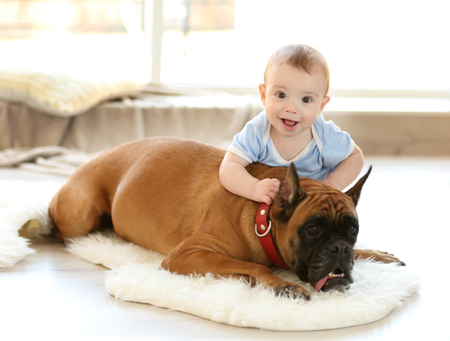
Failure to prepare a dog for the rough handling and grabbing from your baby is the single leading cause for surrendering a dog, as this is the age when the potential for bites first becomes real.
Simultaneously, owners should also have created a “safe zone” for their dog so s/he can retreat – beyond the baby’s reach – when stressed.
Also in this stage is teaching your dog to distinguish child toys from dog toys, which is relatively easy to do.
How to: Begin by getting dog toys that are significantly different in appearance from baby toys. At the same time, dab a little Listerine on all baby toys and teach your dog that the scent of Listerine equals an “off” command. This will go a long way to helping your dog make the right choice.
Most importantly – and this applies at all stages of the child’s development – be sure that your dog and your baby are never, ever left unattended together, even for a moment. This simple and obvious point cannot be stressed enough. Most cases of dog bites on children happen when the owner is out of sight. Once that threshold is crossed, even if the result is only a scratch, the dog’s future with the family begins to look at lot less rosy and the owner is faced with a rapidly narrowing set of choices.
For the sake of your beloved pet, don’t let this happen.
Stage 3: Look who’s Walking
The third critical period comes around 12 months (give or take) when your baby starts walking. This shouldn’t present a major stumbling block if the owners have crossed the first two thresholds successfully. Rather, it will allow parents to begin focusing on structured, fun interactions between their child and dog, such as appropriate games, rudimentary pseudo-training and more (click here for a nice video example of this).
—————
To summarize, taking the time to prepare your dog for the arrival of your baby can pay dividends, put your mind at ease, and offer a wholesome and mutually rewarding relationship for all family members involved.
On the flip side, failing to take the time to prepare your dog for this significant addition to your family can have dire consequences. This is why, tragically, so many new parents end up re-homing their beloved, often older dogs within three to six months of a baby’s arrival.
It needn’t be this way.
In a perfect world, dog owners have roughly 16 months from the time they find out they are pregnant to the day their baby begins to crawl. That’s a lot of time to prepare their dog properly. Thanks and good luck!
———-
Mike’s complete e-course (Preparing Your Dog For Childlike Handling and Dogs Who are Afraid of Children) is now available online for $39 (the individual courses are available for $29).
Keep in mind this isn’t something you can do in one day; rather, it’s something you work at over a period of time in preparation for the various stages discussed above. It’s advised to start early ~ as soon as you know you are pregnant up to a month before your baby is due.
Best of luck! Meg

This was an awesome read, I shared it on my business facebook Baby Jujube for my subscribers.
Hi there,
I’m the author of the article and appreciate the compliment. Just visited your FB page – nice!
If there’s anything around this subject you’d like me to put together for your page or website I’d be happy to do it. This is such an important topic that’s profoundly under appreciated.
To find out more check out my website at http://www.gooddoghappybaby.com.
Thanks for posting this on your page!
Love LOVE love the step by step process to prepare for baby’s arrival with dog. How do these steps apply to owners of multiple dogs?
For owners of multiple dogs all the same principles apply but are potentially more complex depending on what the dog’s issues are. But essentially it’s the same thing all the way around…
My Son just turned 8 months and our dog who is 7 has still not warmed up to him. It is him specifically that she does not like and we do not know what to do to help her warm up to him…it is beginning to concern me. She has developed separation anxiety and runs across the room the second he is in her bubble. Will the course help with dealing with dogs that still need help adjusting or is it only good for preemptively working with your dog? We thought we were preparing her but i guess we didn’t do the right things….she is definitely jealous
.
Hi Jessica, I’m sorry you’re dealing with this 🙁
Here’s what Mike has to say: Module 1 of the course would help a lot. Also, look in my book Good Dog, Happy Baby for help with issues of separation anxiety.
Both places have suggestion for creating a safe space for the dog and the video course has a ton of information on how to slowly get the dog used to baby’s touching, encroaching, etc. This is the number one reason that people re-home dogs and why it was the first module I produced.
For any other questions, Mike says that you can reach out to him directly at [email protected]
Hi Melissa! Thanks for putting such an effort in developing this post. You have solved mine and every parent’s problem. My dog is a wonderful pet and he seems to be waiting desperately for the new comer in the family. I hope they get along well.